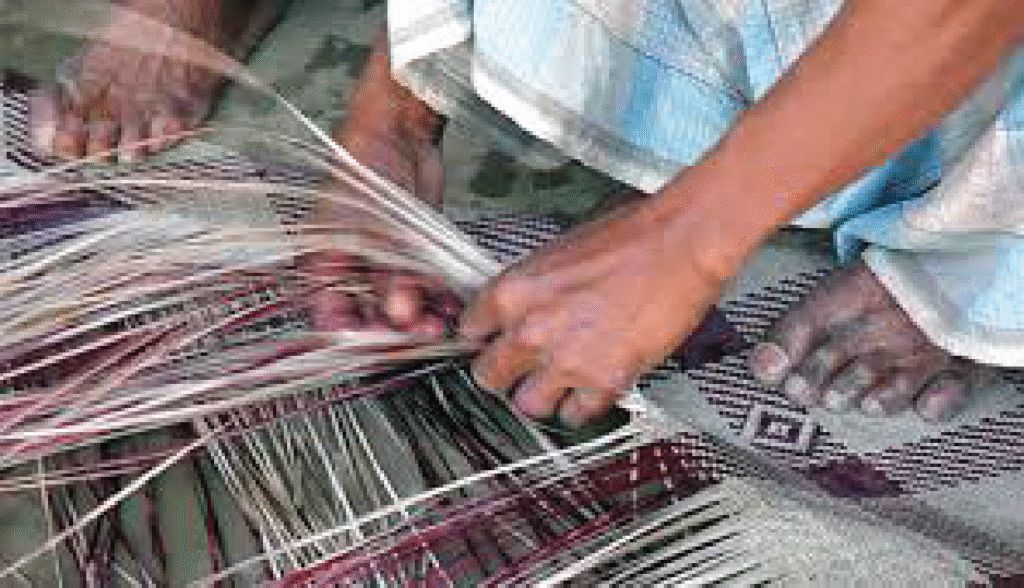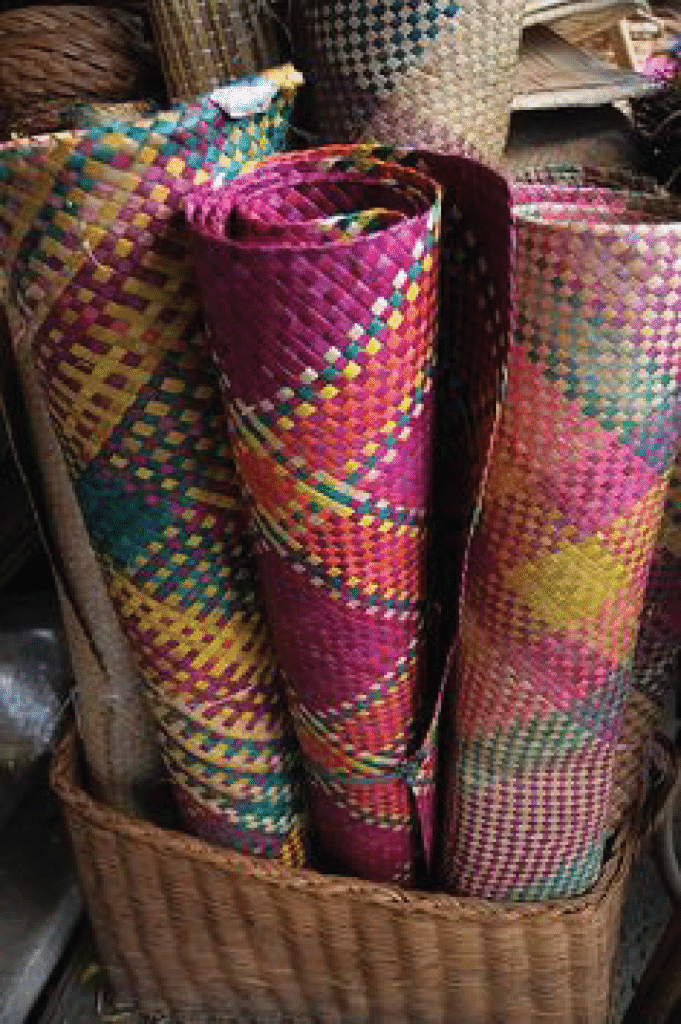Shital Pati
Shitol Pati, commonly spelled “Shital Pati,” is a traditional craft and art form that has its roots in the Sylhet region of Bangladesh. It is deeply ingrained into Sylhet’s regional legacy and is of major cultural and historical significance. Shitalpati holds a connection with the way of life in Bengal. The process of extracting the fibres from the cane plays a role in determining the quality of the Pati. Locally known as Murta (a word for pearls as the seeds resemble them) ,the cane is cultivated in every household and its stems are utilized to create strips for weaving. These strips are sometimes dyed in colours featuring intricate designs inspired by animals such as peacocks, butterflies, birds cats and more. Traditionally Shitalpati is used for sleeping and sitting purposes. There are different types of Pati for exaple Kamalkosh (renowned for its superior finesse), Mihi Shital Bhushnai Pati, Mota Shital Dalar Pati and others.
Tracing the roots of shitalpati
The history of Shital Pati is intertwined with the passage of time stretching back to centuries when skilled artisans in Bengal utilized the gifts of nature to craft something visually appealing. The name itself derived from “Shital” meaning cool and “Pati” representing a strip and these reflect the origins of this art form. However Shital Pati goes beyond functionality; it serves as a symbol of the identity and ingenuity found within the region.
Shital Patti is described in the following way in Chapter 4 of Volume 1 of “History of Srihatta” authored by Achyutacharan Chowdhury Tattvanidhi and published in the 1920s: “Shital Patti is the most important and most famous of these industries. It is produced from the bark of a plant called Murta. It is loved globally for being cool, silky and pleasant. These rugs are used as gaming boards for pasha, chess etc. The price of the rug might range from 10 annas to 10 taka depending on the quality. The thinner the stems, the pricier it gets. A 20-21 hand long rug is called ‘saf’. Eet and Chonalish Parganas produced the greatest Shital Pati. Carpet makers are known as ‘Patiara Das’. In 1876-77 A.D. rugs worth 3927 rupees were shipped from Srihatt”
Legend of the Cooling Weave: Myth and mystery
Behind each item of heritage there is a story that rises above the reality and Shital Pati is no exception. The story goes on like that a talented weaver once wove together strings of moon and delicate breezes to create a texture that offered reprieve from the intense heat. This myth adds on to the atmosphere of charm in this art entwining nature’s components with human creativity.

From bark to beauty: Crafting shitalpati
The making of Shitalpati is a complex process. First of all the bark of the tree is carefully removed and its fibres are skilfully woven into delicate ribbons. These strips are then dyed with an array of colours and woven into intricate patterns. The final step in creating a shitalpati is to carefully stitch the woven strips together to create the finished product. This requires great precision and attention to detail as the weaver must ensure that each strip aligns perfectly with the others. Once completed Shitalpati is ready to display in homes. It can be used as a wall hanging or even as a decorative table runner and so on. This traditional craft brings a feeling of tradition and cultural heritage to modern interiors while adding a touch of sophistication and warmth to any room.
Weavers of Shital Pati
Most of the weavers of shital pati can be found in the low-lying villages of Sylhet. But there are also few weavers living in the other parts of the country. Majority of the weavers are women, however men also participate in collecting and processing of Murta as well as in the weaving process. Over the time the number of people involved with the weaving of shitalpati lessened as they are changing their profession in order to survive in the modern era.
These days most of the remaining weavers are from Balaganj, Gowainghat, Companiganj and few other areas from Sylhet district. Kashipur ,a village from Balaganj is famous for its shitalpati, and there are 15-20 families who are still involve with weaving shitalpati. Once there used to be more families who used to weave but with time they lost their interest in this profession. Beside Sylhet, other areas of Bangladesh such as Noakhali, Sirajganj, Chittagong, Pabna are also known for their shitalpati.
Where Tradition Meets Modernity
Shital Patti has transcended its roots and evolved to meet current tastes. Today the craft offers a diverse range of products from traditional sleeping and sitting mats to modern items such as bags, mobile covers and home decor accessories. For those looking to own a piece of this heritage, authentic shitalpati can be found in Sylhet’s local markets, craft fairs and dedicated artisan stores. Shitol Pati mats have cultural and ceremonial importance in addition to being useful. They are frequently used in homes, as well as at other religious and social occasions, as prayer mats, floor coverings, and in seating areas. These mats are also frequently used in customary rituals and ceremonies, further solidifying their significance in Sylhet’s cultural landscape. These resources offer not only a product but also a connection to centuries-old practice and the skilled hands that bring it to life.

Owning a Piece of History
Owning an authentic ShitalPati is not just about adding a touch of beauty in our hoe home but with this we can also support the livelihood of these talented weavers ensuring that this traditional art form continues to thrive. There are many types of shitalpatis out there with different names and design. Such as, Arua, Siki, Poysha, Sonamuri, Tikka, Tara, Shapla, Noyantara etc. are the most common types of shitalpati. Shitalpati such as Lalgalicha, Mihi etc, are considered as special as most of the time weavers make them only when they receive special request from customers. Prices for these patis also differ from each other, ranging from 500 taka to 10,000 taka. Price normally depends on the designs, patterns and type of patis. Salutikar bazar from Sylhet is famous for selling shitalpati, every Saturday and Tuesday from 10am to 2pm. In addition to this there are also few big and small markets and stores all over the Sylhet that sells shitalpati.
Preserving Legacy: The Role of Shital Pati Today
While exploring the past and present of Shital Pati, it is important to note down its role in preserving the cultural heritage and supporting the local artisans. Skilled weavers make a living from this craft and keep the traditional heritage alive. Apart fro being traditional, shitalPati is environment friendly and quipped for responsible artistry. The intricate weaving techniques and natural materials used in making Shital Pati reflect the rich history and craftsmanship passed down through the generations. By supporting the production and sale of Shital Pati we increase the economic empowerment of these artisans and help preserve their traditional way of life. UNSCO declared shitalpati as one of the world’s heritage in 2017. With this the value of shitalpati increased a lot, so to preserve its legacy everyone from government, private sectors and everyone from this country should work together and make shitalpati and its history known to the world.











